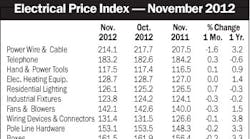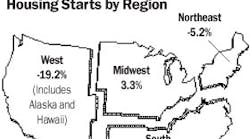Latest from Mag
People - Dec 21, 2012
Obituaries - Dec 21, 2012
November EPI Index Shows No Change
Housing Starts Dip 4% in November
Electrical Marketing - December 21, 2012
Around the Industry - Dec 21, 2012
Speculation continues that Wolsely plc, Reading, England, the world’s largest distributor of plumbing, heating and building products, could make a big move into the U.S. electrical market in the near future.
John R. English, Wolseley’s vice president, investor relations, North America, said the company would be interested at some point in time in being involved in the electrical distribution business, but that it has no imminent plans. “It (the electrical distribution business) is an area that we’re constantly looking at, along with other areas,” he said. “Certainly if opportunities came along — at some point in time whether it’s a year from now or 10 years from now — we would certainly continue to look at opportunities in that area. There’s nothing definite.”
English said one of Wolseley’s U.S. subsidiaries, Ferguson Enterprises, Newport News, Va., has lighting showrooms and provides lighting fixtures, but that it does not focus on the mainstream electrical market. “We’re not in the electrical distribution business that most people would consider — all the supply and the rough material and boxes and breakers and things like that. We may have acquired someone who sells a little electrical in some really small markets. So it’s a small piece of our business. Even with the United Kingdom in it, it’s still a very small piece of our business at this stage.”
Still, the company is counted as one of the largest consolidators in the international distribution business. Larry Stoddard, the company’s senior vice president of business development, was one of the featured speakers in a panel discussion that explored consolidation in the distribution market at Brown Gibbons Lang & Co.’s 3rd Annual-Cross Border Conference, held last year in Boston. The other panel participants included representatives from Home Depot, U.S. Electrical Services, Clayton, Dubilier & Rice and Code Hennessy & Simmons.
Wolseley has approximately 79,000 employees working in 27 countries, and reported $25.2 billion in fiscal 2006 sales last year. Wolseley’s North American subsidiaries include Ferguson Enterprises; Stock Building Supply, Raleigh, N.C., a distributor of construction products; and Wolseley Canada, which has 230 branches serving the plumbing, heating and ventilation markets. Ferguson Enterprises had $7.1 billion in 2005 revenue and 1,100 branches in North America, and Stock Building Supply had $4.1 billion in 2005 revenue, and 307 locations in 33 states. About 60 percent of Wolseley’s business is in North America. Industrial Distribution magazine’s 2006 Top 50 listing ranks Wolseley as the largest industrial distributor in the world.
While Wolseley for years has long been a big player in the United Kingdom’s building supply and plumbing industries, the company recently moved into that country’s electrical distribution business in 2006 through the purchases of William Wilson and AC Electrical. In the United States, Wolseley followed suit with the acquisition of Efficient Electric and United Electric, two Las Vegas-based contractors with a taste for residential work and DSI, a Las Vegas-based electrical distributor. Since the start of its Aug. 1 fiscal year, Wolseley has spent $635.4 million on 29 acquisitions in Europe and North America.
Like many of its competitors, Wolseley has been hurt by the downturn in the U.S. housing construction market. It eliminated about 4,000 jobs in the last five months of 2006 because of the housing slump. About 3,500 of the cuts, mainly in Nevada, California, Florida and Michigan, were in the Stock Building Supply division. Another 500 job cuts were in the Ferguson division. Wolseley expects the down cycle in the U.S. housing market to continue over several months.
According to a company statement, Wolseley’s earnings for the five months ended Dec. 31 were hurt by the slowdown in the housing market. Profit before tax and amortization of acquired intangibles for the period was 14 percent lower than the year-ago period.
